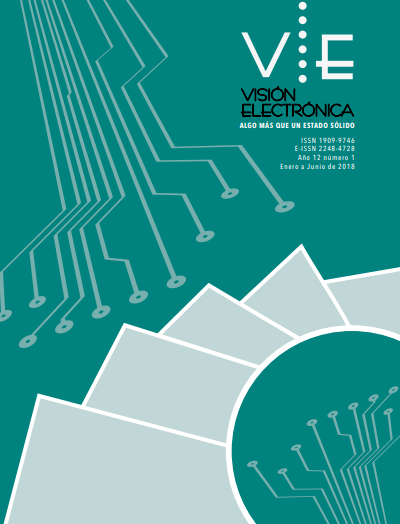DOI:
https://doi.org/10.14483/22484728.13310Published:
2018-05-30Issue:
Vol. 12 No. 1 (2018)Section:
A Research VisionDispositivo háptico vibrotáctil inalámbrico para asistencia de actividades motoras
Wearable Haptic Vibrotactile System for Assistance of Motor Activities
Keywords:
deficit of movement, haptic feedback, touch perception (en).Keywords:
déficit de movimiento, percepción táctil, retroalimentación háptica (es).Downloads
Abstract (es)
El presente artículo describe la investigación que condujo al desarrollo de un dispositivo háptico inalámbrico, capaz de generar estímulos mecánicos vibrotáctiles en diferentes puntos de la piel—y a frecuencias deseadas—por medio de dieciséis actuadores contenidos en un brazalete portátil diseñado para cualquier extremidad del cuerpo humano. Este prototipo permite tener control sobre cada actuador usado como punto de estimulación, accionado de forma independiente por medio de comandos transmitidos inalámbricamente hacia un sistema de control autónomo recargable dispuesto en el brazalete. Se realizaron pruebas de usabilidad, con respecto a la percepción táctil, que comprobaron el correcto funcionamiento del dispositivo. En perspectiva, el desarrollo, luego de una variedad de pruebas de validación con una amplia muestra de pacientes con y sin neuropatías, tiene como fin la creación de una base de datos para ser usada como valores consigna frente a estos pacientes—esperando que el sistema se use también en pacientes con déficit de movimiento— y empleando la percepción táctil como estimulante psicomotor en la ejecución de actividades motoras.
Abstract (en)
This article describes the research that leads to the development of a wireless haptic device capable of generating vibrotractile mechanical stimuli at different points in the human skin and at desired frequencies by means of 16 actuators contained in portable bracelet isolated, designed for any extremity of the human. This prototype allows control over each actuator used as a test point, independently driven by commands transmitted wirelessly to a self-contained rechargeable control system placed on the bracelet. The completion and use of this system allowed to perform usability tests with respect to tactile perception from three experiments in healthy people, who verified the efficiency of the vibrotactile flux in the discrimination of nearby stimuli and the correct functioning of the device. With the development of this device want to perform it a wide variety of validation tests with a large sample of patients with and without neuropathies, in order to create a database to be used as set values against these patients and it is expected that the system is also used in patients with movement deficit, using tactile perception as a psychomotor stimulant in the execution of motor activities.
References
M. H. Beers y R. Berkow. “The Merck manual of diagnosis and therapy”. New Jersey: Merck Research Laboratories, 1999.
A. Frisoli, F. Salsedo, M. Bergamasco, B. Rossi y M. C. Carboncini, “A force-feedback exoskeleton for upper-limb rehabilitation in virtual reality”, Applied Bionics and Biomechanics, vol. 6, nº. 2, pp. 115–126, 2009. https://doi.org/10.1155/2009/378254
M. A. Padilla-Castaneda, E. Sotgiu, A. Frisoli, M. Bergamasco, P. Orsini, A. Martiradonna, S. Olivieri, G. Mazzinghi y C. Laddaga, “A virtual reality system for robotic-assisted orthopedic rehabilitation of forearm and elbow fractures”, IEEE/RSJ International Conference on Intelligent Robots and Systems, 2013, pp. 1506–1511. https://doi.org/10.1109/IROS.2013.6696548
M. S. Cameirao, S. B. I Badia, E. Duarte, A. Frisoli y P. F. M. J. Verschure, “The combined impact of virtual reality neurorehabilitation and its interfaces onupper extremity functional recovery in patients with chronic stroke” Stroke, vol. 43, nº. 10, pp. 2720–2728, 2012. https://doi.org/10.1161/STROKEAHA.112.653196
A. Frisoli, C. Procopio, C. Chisari, I. Creatini, L. Bonfiglio, M. Beramasco y M.C. Carboncini, “Positive effects of robotic exoskeleton training of upper limb reaching movements after stroke”Journal of NeuroEngineering and Rehabilitation, vol. 9, nº. 1, pp. 1–16, 2012. https://doi.org/10.1186/1743-0003-9-36
J. Chirivella, A. Barco, S. Blasco, V. Penades, G. Mas y P. Gagliardo, “Neuro@ home [ii]: A software platform of clinically designed videogames designed for the cognitive rehabilitation of stroke patients”, in Brain Injury, pp. 517–878, 2014.
A. L. Faria, A. Andrade, L. Soares y S. B. I Badia, “Benefits of virtual reality based cognitive rehabilitation through simulated activities of daily living: a randomized controlled trial with stroke patients”,Journal of NeuroEngineering and Rehabilitation, vol. 13, nº. 1, 2016. https://doi.org/10.1186/s12984-016-0204-z
F. J. Badesa, R. Morales, N. Garcia-Aracil, J. M. Sabater, A. Casals y L. Zollo, “Auto-adaptive robot-aided therapy using machine learning technique”, Computer Methods and Programs in Biomedicine, vol. 116, nº. 2, pp. 123–130, 2014. https://doi.org/10.1016/j.cmpb.2013.09.011
O. M. Giggins, U. M. Persson y B. Caulfield, “Biofeedback in rehabilitation”, Journal of NeuroEngineering and Rehabilitation, vol. 10, nº. 1, 2013. https://doi.org/10.1186/1743-0003-10-60


1.png)




.jpg)





